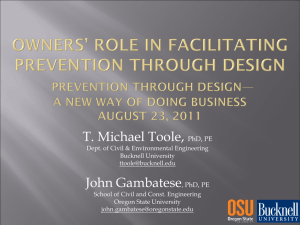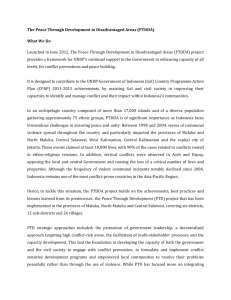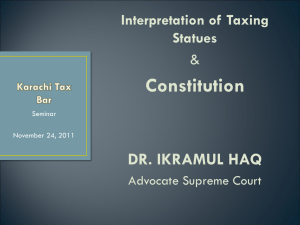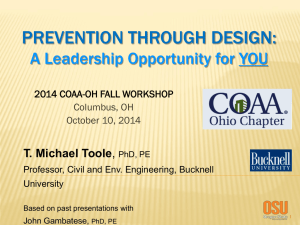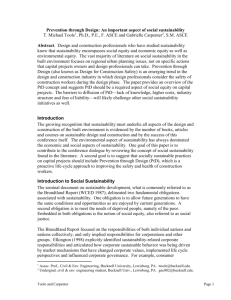Read actions that owner organizations should take to effectively
advertisement
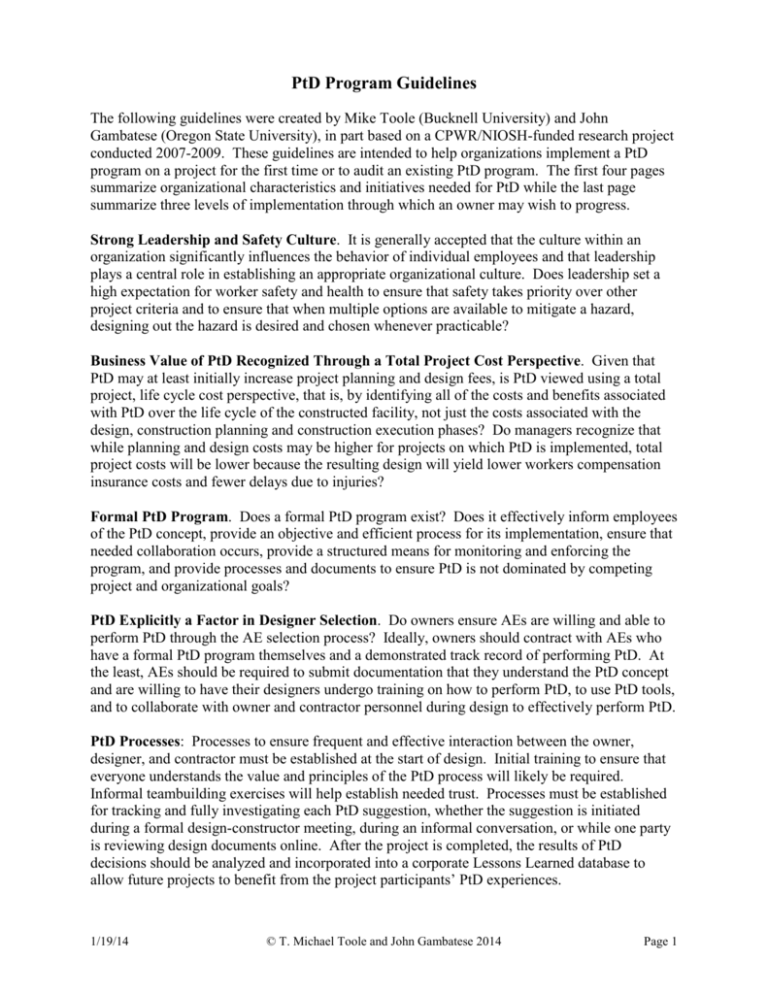
PtD Program Guidelines The following guidelines were created by Mike Toole (Bucknell University) and John Gambatese (Oregon State University), in part based on a CPWR/NIOSH-funded research project conducted 2007-2009. These guidelines are intended to help organizations implement a PtD program on a project for the first time or to audit an existing PtD program. The first four pages summarize organizational characteristics and initiatives needed for PtD while the last page summarize three levels of implementation through which an owner may wish to progress. Strong Leadership and Safety Culture. It is generally accepted that the culture within an organization significantly influences the behavior of individual employees and that leadership plays a central role in establishing an appropriate organizational culture. Does leadership set a high expectation for worker safety and health to ensure that safety takes priority over other project criteria and to ensure that when multiple options are available to mitigate a hazard, designing out the hazard is desired and chosen whenever practicable? Business Value of PtD Recognized Through a Total Project Cost Perspective. Given that PtD may at least initially increase project planning and design fees, is PtD viewed using a total project, life cycle cost perspective, that is, by identifying all of the costs and benefits associated with PtD over the life cycle of the constructed facility, not just the costs associated with the design, construction planning and construction execution phases? Do managers recognize that while planning and design costs may be higher for projects on which PtD is implemented, total project costs will be lower because the resulting design will yield lower workers compensation insurance costs and fewer delays due to injuries? Formal PtD Program. Does a formal PtD program exist? Does it effectively inform employees of the PtD concept, provide an objective and efficient process for its implementation, ensure that needed collaboration occurs, provide a structured means for monitoring and enforcing the program, and provide processes and documents to ensure PtD is not dominated by competing project and organizational goals? PtD Explicitly a Factor in Designer Selection. Do owners ensure AEs are willing and able to perform PtD through the AE selection process? Ideally, owners should contract with AEs who have a formal PtD program themselves and a demonstrated track record of performing PtD. At the least, AEs should be required to submit documentation that they understand the PtD concept and are willing to have their designers undergo training on how to perform PtD, to use PtD tools, and to collaborate with owner and contractor personnel during design to effectively perform PtD. PtD Processes: Processes to ensure frequent and effective interaction between the owner, designer, and contractor must be established at the start of design. Initial training to ensure that everyone understands the value and principles of the PtD process will likely be required. Informal teambuilding exercises will help establish needed trust. Processes must be established for tracking and fully investigating each PtD suggestion, whether the suggestion is initiated during a formal design-constructor meeting, during an informal conversation, or while one party is reviewing design documents online. After the project is completed, the results of PtD decisions should be analyzed and incorporated into a corporate Lessons Learned database to allow future projects to benefit from the project participants’ PtD experiences. 1/19/14 © T. Michael Toole and John Gambatese 2014 Page 1 Project Delivery Method. Even if designers are knowledgeable about construction safety and PtD, collaboration during design between designers, the lead contractor, construction trades, and construction safety professionals is a key component of an effective PtD program. The traditional design-bid-build method of delivering projects typically does not allow this collaboration because the firms who perform construction are not identified until after design is complete. As such, design-build and integrated project delivery (IPD) are two preferred project delivery methods for enabling effective PtD on a project because they enable the needed collaboration. Design Contract Type: Owners who wish to engage an AE who has not previously performed PtD may wish to agree to have the contract with the AE be a Cost-Plus with a guaranteed maximum price (GMP) contract rather than a traditional fixed fee contract, because such a designer may be hesitant about locking in a price for a process with which they are not familiar. Contractual Obligations. Although it is more difficult to effectively perform PtD on a traditional design-bid-build project, it is not impossible. An owner could choose to require the AE to perform PtD without being able to collaborate with construction personnel during design, or an owner could engage a general contractor and several key trade contractors to act as safety review consultants during the design process (perhaps as part of a Design-Assist contract). With either arrangement, it will be necessary to ensure the contract between the owner and the AE requires or at least recognizes that the AE will perform PtD on the project. Mike Toole and John Gambatese have suggested changes to reflect this process on two model contract documents promulgated by the Engineers Joint Contracts Committee (EJCDC, a joint body of the American Society of Civil Engineers, the National Society of Professional Engineers and the Associated General Contractors.). The E-500 is a model contract (i.e., boiler plate) contract between and owner and design engineering on a design-bid-build project. The E-700 is model general conditions that govern a general contractor and subcontractors on a design-bid-build project. (The documents are analogous to the B-141 and the A201, respectively, promulgated by the American Institute of Architects.) Please contact Dr. Toole or Dr. Gambatese to obtain copies of these suggested changes. Constructability Reviews. The key collaboration with PtD is associated with constructability reviews, that is, when designers and construction personnel meet to discuss aspects of the design that may cause the construction of the design to cost more, take longer, or be of lower quality than is desired. Ideally, such constructability reviews occur at approximately the 10%, 30%, 60% and 90% stages of design, involve individuals representing all relevant engineering disciplines, in-house construction safety, external trades, operational safety, and cost accounting, and include the specific review tasks shown in the figure on the following page. A mistake that is common on construction projects is not to hold the first constructability review until later in the design process. As suggested in the figure on the next page, opportunities for identifying and facilitating prefabrication and modularization disappear around the 30% design stage. Because prefabrication and modularization can dramatically reduce construction injuries over “stick-built” construction (Toole and Gambatese 2009), constructability reviews that do not start until after the 30% design stage have significantly lower potential for designing a facility that is inherently safer to construct. Two brief examples from recent construction projects illustrate the importance of early consideration of construction safety. During the concept design of large dam project on the 1/19/14 © T. Michael Toole and John Gambatese 2014 Page 2 Figure: An Ideal Constructability Review Process Mississippi River, the project owner stated the desire to have the project completed without putting scuba divers in the water to inspect the construction, which is typical on such dam projects. This safety goal led the program manager to decide to use very large precast concrete modules. A similar principle is associated with a large solar boiler project being constructed in the Mojave Desert. The Program Manager’s desire to reduce the amount of construction work performed at height led them to design the 400’ tower to be assembled from very large prefabricated modules. Although the use of prefabricated modules on both projects will lead to substantial time, cost, and quality benefits as well, it is less likely that the modules would have been pursued if construction worker safety had not been explicitly considered and valued during the concept design phase. Collaboration Enhancing Processes. Several special process elements are effective at enabling PtD (and constructible and high-quality design in general). First, designers and key construction personnel should be co-located (i.e., have nearby offices) throughout the design. Second, the owner should allocate sufficient time for the design stage, rather than constantly pushing for the design to be completed as soon as possible, which is common in the industry. Third, design and construction personnel must develop trusting relationships through a team-building retreat at the start of the design process. Fourth, the project personnel should use collaborative decisionmaking tools, such as those associated with lean construction. Fifth, design and construction personnel can share common financial incentives that drive each party to pursue the goals of the project, not just those of their employer. Although IPD is intended to maximize constructability input into a project’s design, construction worker safety is not always explicitly included in the constructability review process. Mike Toole and John Gambatese have drafted text that could be added to a typical IPD contract to 1/19/14 © T. Michael Toole and John Gambatese 2014 Page 3 ensure that AEs participating in an IPD project recognize that construction worker safety must be a key design criterion. PtD-Related Knowledge. Even if collaboration between designers and construction personnel is frequent and cordial, having PtD performed efficiently will be difficult if designers possess insufficient knowledge of construction hazards, construction means and methods, and potential design alternatives to improve safety. Owner firms may wish to hire only AE firms that provide their design employees with training on construction safety. For example, one large EPC firm has provided many of their design engineers with sixteen hours of construction safety training. Owners should also consider giving preference to AE firms that ensure the professional development of engineers (especially young employees) includes a field assignment in order to gain knowledge of construction means and methods. Finally, owners may wish to require AE employees to complete PtD-training before they are allowed to work on the owner’s projects, as a large mining company has required for AEs working on a large building program in western Canada. PtD Tools. Given that most design professionals lack sufficient knowledge of construction safety and PtD opportunities, owners should insist that design professionals have access to discipline-specific PtD checklists. Such checklists can be created in-house or secured from external sources. The Construction Industry Institute PtD tool developed by Professors J. Hinze and J. Gambatese provide a database of over 400 individual checklists, organized by construction phase (such as concrete, steel erection, etc.). The www.designforconstructionsafety.org website includes a spreadsheet containing 1700 PtD examples and checklists that was compiled by Mr. Alan Speegle at the Southern Company. The Australian CHAIR system is another available tool. Design managers should also consider providing their employees with reference tools and websites for increasing their employees’ knowledge of construction safety in general and opportunities for designing for safety. Government agencies within the UK, Australia and Singapore have developed helpful tools that can be identified and accessed through links provided at www.designforconstructionsafety.org. Many process/industrial construction owners have created lengthy and detailed risk assessment documents and require their use as part of a prescribed risk management process. These documents can serve as a tool to help designers follow a structured process to ensure all potential safety hazards are identified. It should be noted, however, that owners who wish to implement PtD on their projects should not assume their existing capital project risk management documents and processes sufficiently address construction worker safety. Information Technology Infrastructure: Owner, designer, and construction personnel must be able to easily access draft design documents and share PtD-related and other constructability comments. A system must exist that facilitates tracking specific design suggestions from inception to closure. As such, a commercially-available project collaboration software package should be set up at the beginning of the design process, not at the start of construction. An owner seeking to implement PtD on a project should also insist that the designer and key contractor personnel use Building Information Modeling (BIM) software. BIM provides realistic 3D visualization that may allow designers and constructors to identify potential site hazards that are not obvious from viewing 2D plans. Four-dimensional (4D) BIM simulates the construction sequencing over time and allows designers and constructors to identify potential hazards not obvious from viewing static 3D renderings. 1/19/14 © T. Michael Toole and John Gambatese 2014 Page 4 Levels of PtD Implementation It is not the case that Prevention through Design is either implemented or not implemented on a project. There is a continuum of implementation levels and it may be appropriate for owners and architects/engineers (AEs) to progress from a low level of implementation to full implementation. Three levels of PtD implementation are summarized below. Level 1: Invisible PtD Process PtD is not mentioned during the AE proposal and selection process. AE does not ensure its employees and design consultants receive PtD training and does not use PtD design tools, but does consider safety constructability input from owners, CM or GC given during design progress reviews. Level 2: Added PtD Process PtD is not addressed in the owner’s request for proposal (RFP) for design services or in the AE’s proposal to the owner, but agrees (during discussions with owner leading to AE selection) to participate in a PtD process if the following text is included in the contract: “The AE may attempt to consider the safety of construction and maintenance workers during the design of the Project. It is expressly acknowledged that: a) such consideration shall be only to the extent reasonable possible given that AE may be lacking knowledge of the means, methods, techniques, sequences or procedures of construction that the Contractor will use; b) it is impossible for the design to reduce or eliminate all hazards, c) the Contractor retains sole responsibility for the safety of construction workers even for portions of the project on which the AE may have attempted to reduce site hazards through design decisions; d) there will be portions of the Project on which AE has made no effort to reduce hazards through design decisions; and e) that discussions between AE and Contractor or any subcontractor regarding safety or other aspects of the design, shall not be construed to establish a contractual relationship between the AE and Contractor or any subcontractors.” AE sends designers to PtD training given by owner or CM. AE is given PtD design tools by owner or CM and uses them. AE considers safety constructability input from owner, CM, GC, subs during design reviews. Level 3: Ideal PtD Process AE PtD capability is explicitly included in owner RFP and in the AE proposal and selection by owner. AE has internal PtD training program. AE chooses and uses PtD tools. AE has internal safety design reviews. Owner and constructors provide additional safety constructability input that is incorporated into design. AE actively solicits feedback on the safety of final design and uses lessons learned system to improve safety of future projects. 1/19/14 © T. Michael Toole and John Gambatese 2014 Page 5

